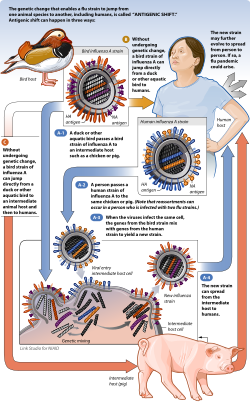Talk:Antigenic shift
| This article is rated Start-class on Wikipedia's content assessment scale. It is of interest to the following WikiProjects: | |||||||||||
| |||||||||||
Viral shift
viral shift should link back here.
About risk of pandemic
"In 2004, scientists pointed out that the avian influenza virus might undergo an antigenic shift with the human flu virus and cause a global influenza pandemic like the one in 1918." The condition for that is there to be an epidemic as the one of influenza type A concomitant with infection of the birds (H5N1 virus). Berton 18:24, 22 March 2006 (UTC)
Death statistic inflated
The stated death toll on this page for the Spanish flu is inflated to 40-100 million dead, Whereas on the Spanish flu page, and in all research I've done, the toll was around 20-40 million (see Breslow, L. (2002). Encyclopedia of public health. New York: Pearson Education, Inc.)
Citations needed
Citations are needed in the first paragraph, where it is stated that the term "antigenic shift" is specific to influenza literature. —Preceding unsigned comment added by 71.204.15.239 (talk) 14:17, 25 April 2008 (UTC)
Antigenic shift is not unique to influenza
This was previously corrected, but some idiot reverted the changes —Preceding unsigned comment added by Danfoste (talk • contribs) 00:09, 26 April 2008 (UTC)
File:AntigenicShift HiRes.svg to appear as POTD soon
Hello! This is a note to let the editors of this article know that File:AntigenicShift HiRes.svg will be appearing as picture of the day on May 19, 2011. You can view and edit the POTD blurb at Template:POTD/2011-05-19. If this article needs any attention or maintenance, it would be preferable if that could be done before its appearance on the Main Page so Wikipedia doesn't look bad. :) Thanks! howcheng {chat} 19:13, 18 May 2011 (UTC)
Image does not show antigenic shift
Does the image really illustrate antigenic shift? To me it looks like it just illustrates 'genetic reassortment' (meaning that segments coding for receptors are not necessarily influenced). The antigens on the new strain (orange and purple are the same as the original avian strain. Antigenic would be a mixture of both avian and human strain; purple and blue /orange and yellow. 2001:638:804:2090:FDBC:DCC2:DAE7:AF7D (talk) 10:58, 17 January 2015 (UTC)
I think the above reader is correct. The receptor layer shows no change. Here is a good article to illustrate the point. https://www.khanacademy.org/science/biology/biology-of-viruses/virus-biology/a/evolution-of-viruses — Preceding unsigned comment added by 173.72.135.141 (talk) 08:17, 10 March 2020 (UTC)


